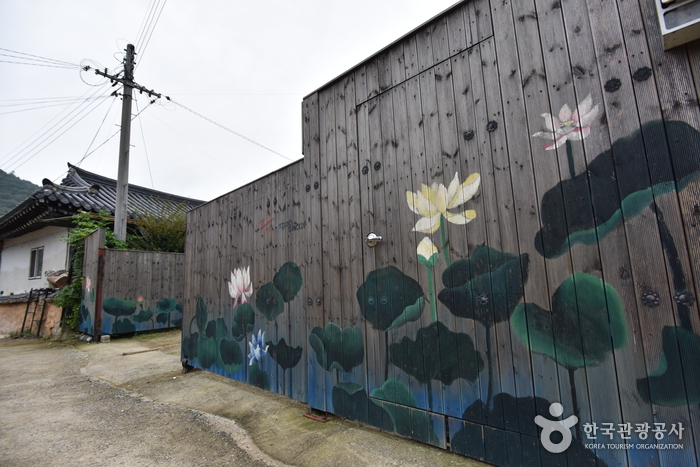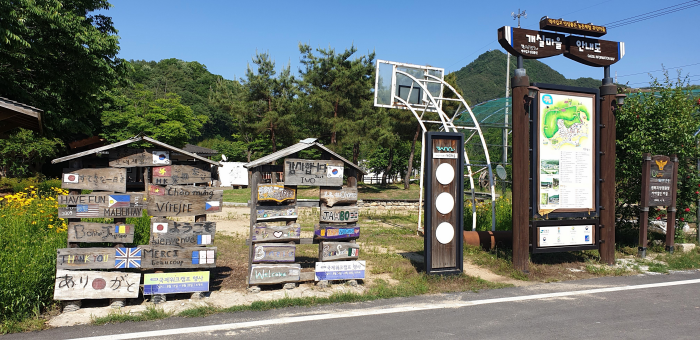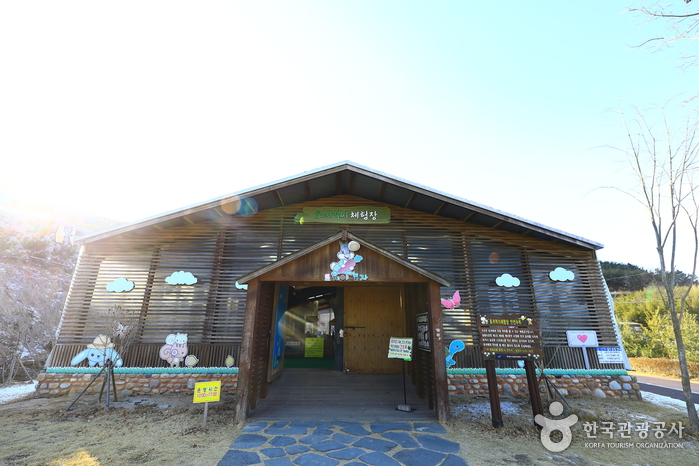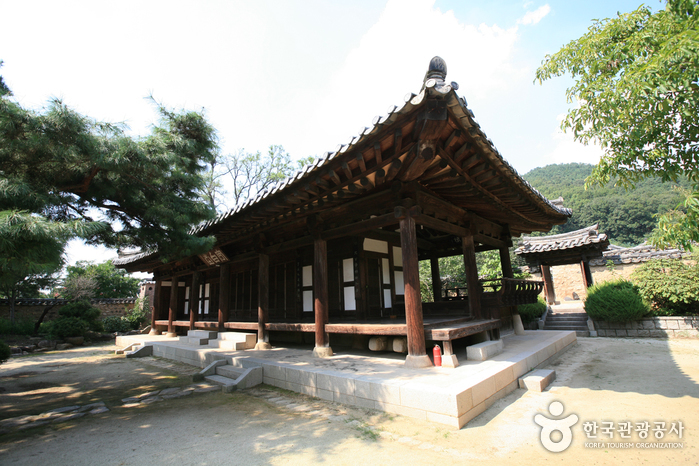The House of Soccer kkumnamu (Future Soccer Player) [Korea Quality] / 축구꿈나무집 [한국관광 품질인증]
13.3Km 2020-09-09
32, Gaesil 1-gil, Ssangnim-myeon, Goryeong-gun, Gyeongsangbuk-do
+82-54-956-4022 / +82-10-3207-4022
The House of Soccer kkumnamu (The House of Future Soccer Player) of the Gaesil Village Farming Association Corporation is a hanok-style accommodation complete with a grassy field and a courtyard filled with well-kept flowerpots, creating a serene atmosphere around the hanok. The house has two Korean-style rooms with a capacity of two to four people. The Nansil room also has a kitchen. This cozy hanok is equipped with modern facilities for guests’ comfort and convenience, as well as the full range of amenities including TV, fridge, air-conditioner, toiletries, and table. Guests are permitted to hold a BBQ outside provided that they supply the charcoal themselves.
Known as the village of the Seonsan Kim clan, Gaesil Village was founded by the descendants of Kim Jong-jik (pen-name: Jeompiljae, 1431-1492), a leading Korean Neo-Confucian scholar of the early Joseon period who died during the Literati Purge of 1498. The head house of Kim Jong-jik (Provincial Folk Material No. 62) and Doyeonjae (Provincial Cultural Heritage Material No. 111), the old village school, are also situated in the village. In addition, the nearby Daegaya Museum displays the writing accessories of Kim Jong-jik (Provincial Tangible Cultural Heritage No. 209).
The village is also known as Gaehwasil, meaning “a beautiful valley with blooming flowers” as it is surrounded by a flower-covered mountain called Mt. Hwagaesan, a 350-year-old bamboo forest, and Jeopmubong Peak, which is said to resemble a fluttering butterfly. Over 80% of the village houses are traditional hanok buildings nestled amid a cozy environment.
During the Campaign to Create Beautiful Communities conducted in 2001 and the Farm Experience Village Development Project in 2005, the village’s hanok were renovated or entirely rebuilt, earthen-stone walls were built, walking paths created, and refined landscaping works carried out, establishing the village in its current form. Furthermore, a village shelter, experience center, Internet café, and other facilities were built for the convenience of residents and visitors alike. In recognition of the villager’ efforts to revitalize their community, Gaesil was awarded the presidential citation at the Korea Rural Village Awards in 2011.
Designated as a NongHyup’s Farm Stay Village in 2003, Gaesil operates a wide variety of hands-on experience programs relating to nature, agriculture, and local traditions, such as collecting sweet potatoes and rice planting; Korean traditional etiquette and tea ceremony; kite making and straw handicrafts; traditional food experiences such as yeot (Korean hard taffy) and yugwa (deep-fried sweet rice cakes); traditional games such as riding on a swing and neolttwigi (Korean see-saw); as well as loach fishing, ice sledding and so on. Gaesil Village, a representative farm stay village that “blooms” in every season, attracts around 50-60,000 visitors every year.
Lang Studio (랑 스튜디오)
13.3Km 2025-06-04
37, Gaesil 1-gil, Goryeong-gun, Gyeongsangbuk-do
Rang Studio is a white-painted hanok guesthouse in Gaesil Village, Goryeong, Gyeongsangbuk-do - hometown of the descendants of Joseon scholar Kim Jong-jik. The guestroom is equipped with a bathroom plus a kitchen with cooking utensils provided. Therfe is an outdoor barbecue, but visitors should bring their own charcoal. In the village, visitors can experience the atmosphere of the old countryside, sampling traditional farming and craft skills plus traditional pastimes and food.
Chuwoojae House [Korea Quality] / 추우재 [한국관광 품질인증]
13.3Km 2021-04-05
20-1, Gaesil 2-gil, Ssangnim-myeon, Goryeong-gun, Gyeongsangbuk-do
+82-54-956-4022 / +82-10-3207-4022
The village of Gaesil is known as the village of the Seonsan Kim clan. It was established by the descendants of Kim Jong-jik (pen-name: Jeompiljae, 1431-1492), a leading Korean Neo-Confucian scholar and the founder of the Yeongnam Sarim faction during the mid-Joseon period. Boasting over 300 years of tradition, the village is home to sixty households as well as a number of cultural heritages including the head house of Kim Jong-jik (Provincial Folk Material No. 62), Doyeonjae (Provincial Cultural Heritage material No. 111), which is the old village school, and the printing woodblocks for a collection of literary works including Yijonrok (a book about the life and achievements of Kim’s father Kim Suk-ja) written by Kim Jong-jik (Provincial Tangible Cultural Heritage No. 175).
The residents have renovated the village’s earthen walls and hanok houses into a current hanok village, and also run various hands-on experience programs including a hanok stay, a farm product cultivation program, and traditional etiquette and games, thereby offering urban travelers an opportunity to experience a truly rural lifestyle. Chuwoojae House, situated in the heart of the village of Gaesil, has two buildings that are available for rent including the bonchae, which is a single-family house, and the sarangchae, which is a detached building). All guestrooms are equipped with a bathroom and cooking facilities. In particular, the bonchae is heated with a furnace. Guests can use the village public parking lot, but there is also a separate parking lot not far from the house.
Hadongdaek House [Korea Quality] / 하동댁 [한국관광 품질인증]
13.3Km 2021-04-05
45, Gaesil 2-gil, Ssangnim-myeon, Goryeong-gun, Gyeongsangbuk-do
+82-54-956-4022, +82-10-3207-4022
The village of Gaesil is known as the village of the Seonsan Kim clan. It was established by the descendants of Kim Jong-jik (pen-name: Jeompiljae, 1431-1492), a leading Korean Neo-Confucian scholar and the founder of the Yeongnam Sarim faction during the mid-Joseon period. Boasting over 300 years of tradition, the village is home to sixty households as well as a number of cultural heritages including the head house of Kim Jong-jik (Provincial Folk Material No. 62), Doyeonjae (Provincial Cultural Heritage material No. 111), which is the old village school, and the printing woodblocks for a collection of literary works including Yijonrok (a book about the life and achievements of Kim’s father Kim Suk-ja) written by Kim Jong-jik (Provincial Tangible Cultural Heritage No. 175).
The residents have renovated the village’s earthen walls and hanok houses into a current hanok village, and also run various hands-on experience programs including a hanok stay, a farm product cultivation program, and traditional etiquette and games, thereby offering urban travelers an opportunity to experience a truly rural lifestyle. The Hadongdaek House has two traditional Korean-style guestrooms. The Maesil room is equipped with a kitchen and a bathroom, while guests who stay in the Juksil should use the communal bathroom and kitchen outside the room. The well-kept garden harmonizes perfectly with the cozy hanok.
Deokdongdaek House [Korea Quality] / 덕동댁 [한국관광 품질인증]
13.3Km 2020-09-09
39, Gaesil 2-gil, Ssangnim-myeon, Goryeong-gun, Gyeongsangbuk-do
+82-54-956-4022 / +82-10-3207-4022
The Deokdongdaek House of the Gaesil Village Farming Association Corporation is an elegant hanok building with a grassy courtyard and a charming atmosphere. This ‘一’-shaped hanok consists of two rooms – the Maesil Room for 2 to 3 people, and the Juksil Room for 3 to 5 people. Each room is decorated with refined hanji wallpaper (Hanji is a traditional Korean paper handmade from the mulberry tree) and equipped with a range of amenities including TV, fridge, air-conditioner, Internet, and toiletries. The Juksil Room is also equipped with cooking facilities, and guests can have a BBQ party in the large courtyard.
Known as the village of the Seonsan Kim clan, Gaesil Village was founded by the descendants of Kim Jong-jik (pen-name: Jeompiljae, 1431-1492), a leading Korean Neo-Confucian scholar of the early Joseon period who died during the Literati Purge of 1498. The head house of Kim Jong-jik (Provincial Folk Material No. 62) and Doyeonjae (Provincial Cultural Heritage Material No. 111), the old village school, are also situated in the village. In addition, the nearby Daegaya Museum displays the writing accessories of Kim Jong-jik (Provincial Tangible Cultural Heritage No. 209).
The village is also known as Gaehwasil, meaning “a beautiful valley with blooming flowers” as it is surrounded by a flower-covered mountain called Mt. Hwagaesan, a 350-year-old bamboo forest, and Jeopmubong Peak, which is said to resemble a fluttering butterfly. Over 80% of the village houses are traditional hanok buildings nestled amid a cozy environment.
During the Campaign to Create Beautiful Communities conducted in 2001 and the Farm Experience Village Development Project in 2005, the village’s hanok were renovated or entirely rebuilt, earthen-stone walls were built, walking paths created, and refined landscaping works carried out, establishing the village in its current form. Furthermore, a village shelter, experience center, Internet café, and other facilities were built for the convenience of residents and visitors alike. In recognition of the villager’ efforts to revitalize their community, Gaesil was awarded the presidential citation at the Korea Rural Village Awards in 2011.
Designated as a NongHyup’s Farm Stay Village in 2003, Gaesil operates a wide variety of hands-on experience programs relating to nature, agriculture, and local traditions, such as collecting sweet potatoes and rice planting; Korean traditional etiquette and tea ceremony; kite making and straw handicrafts; traditional food experiences such as yeot (Korean hard taffy) and yugwa (deep-fried sweet rice cakes); traditional games such as riding on a swing and neolttwigi (Korean see-saw); as well as loach fishing, ice sledding and so on. Gaesil Village, a representative farm stay village that “blooms” in every season, attracts around 50-60,000 visitors every year.
Aldea Gaesil (개실마을)
13.4Km 2022-05-10
Gaesil 1-gil 29, Ssangnim-myeon, Goryeong-gun, Gyeongsangbuk-do
La aldea Gaesil está situada en Gyeongsangbuk-do, enfrente del pico Jeopmubong, con forma de mariposa. Hay muchas leyendas sobre protocolo coreano que proceden de este lugar. Una de ellas hace mención a una familia en la que los hijos han apoyado siempre a sus padres durante 5 generaciones. Cuando la madre enfermó, un faisán voló hasta la cocina. En invierno, una carpa saltó del estanque. Por esta leyenda, el pueblo también ha sido llamado "Ingeobaemi". Al contrario que otros pueblos, los descendientes de la aldea Gaesil han mantenido sus tradiciones, como el protocolo y la devoción a los padres, que se puede experimentar durante la estancia en la aldea.
Parque Santokki (산토끼 노래동산)
13.7Km 2023-06-28
Ibang-ro 623, Ibang-myeon, Changnyeong-gun, Gyeongsangnam-do
Aldea Chumak de Samunjin (사문진 주막촌)
15.5Km 2023-11-13
Samunjin-ro 1-gil 40-12, Hwawon-eup, Dalseong-gun, Daegu
Complejo Recreativo Hwawon (화원유원지)
15.9Km 2023-02-03
Samunjinro 1-gil 40-14, Hwawon-eup, Dalseong-gun, Daegu
Área Residencial Original del Clan Mun de Nampyeong (남평문씨본리세거지)
16.5Km 2021-03-16
Inheung 3-gil 16, Hwawon-eup, Dalseong-gun, Daegu.
+82-53-668-3162
Todo lo que queda de la aldea del clan Mun en Nampyeong, de principios del siglo XVIII, son nueve casas tradicionales y dos glorietas construidas en el estilo de las postrimerías de la época de Joseon. La glorieta ubicada en la entrada de Subongjeongsa, el edificio principal del complejo residencial, fue la más utilizada para recibir a los invitados a su llegada, o como lugar de reunión para la familia. ‘Moon Lovers - Scarlet Heart Goryeo’ es solo una de las muchas telenovelas que han filmado escenas aquí, gracias a la belleza del paisaje formado por las casas tradicionales hanok y los callejones bordeados por muros de piedra.
![The House of Soccer kkumnamu (Future Soccer Player) [Korea Quality] / 축구꿈나무집 [한국관광 품질인증]](http://tong.visitkorea.or.kr/cms/resource/77/2629377_image2_1.jpg)

![Chuwoojae House [Korea Quality] / 추우재 [한국관광 품질인증]](http://tong.visitkorea.or.kr/cms/resource/67/2530167_image2_1.jpg)
![Hadongdaek House [Korea Quality] / 하동댁 [한국관광 품질인증]](http://tong.visitkorea.or.kr/cms/resource/44/2556344_image2_1.jpg)
![Deokdongdaek House [Korea Quality] / 덕동댁 [한국관광 품질인증]](http://tong.visitkorea.or.kr/cms/resource/32/2573332_image2_1.jpg)




 Español
Español
 한국어
한국어 English
English 日本語
日本語 中文(简体)
中文(简体) Deutsch
Deutsch Français
Français Русский
Русский